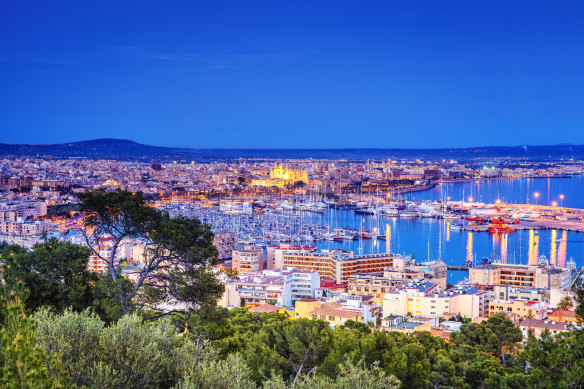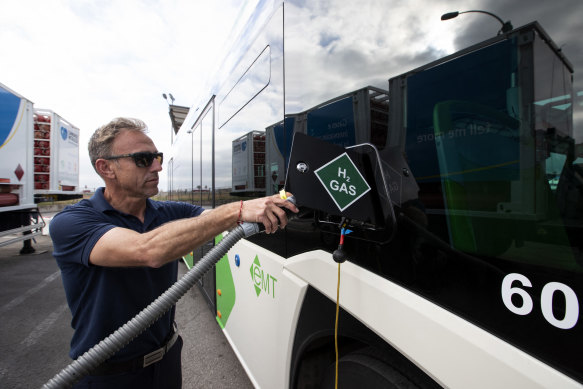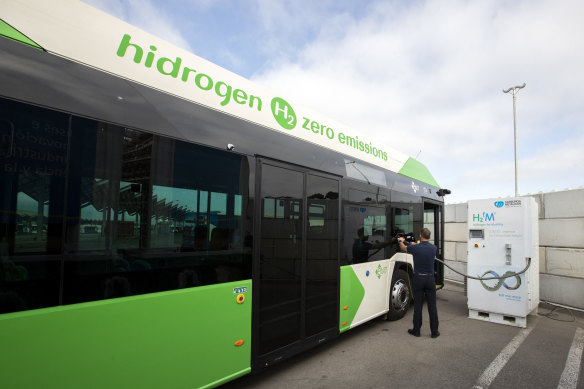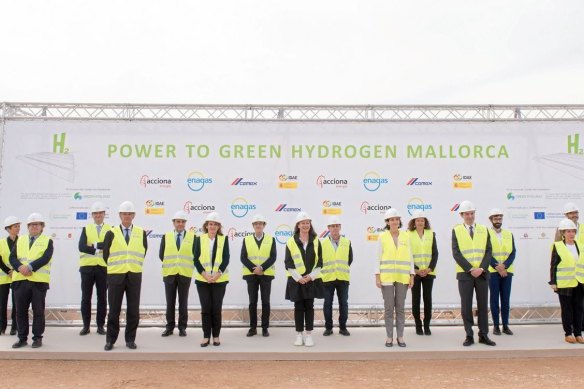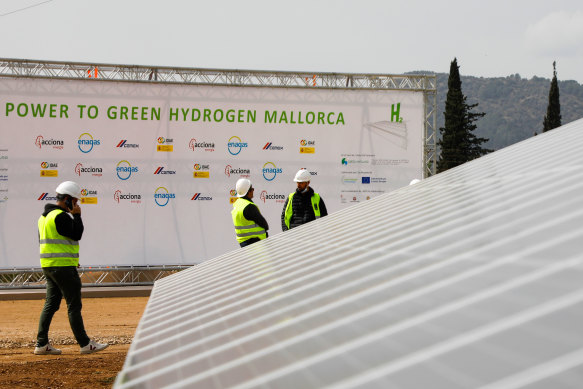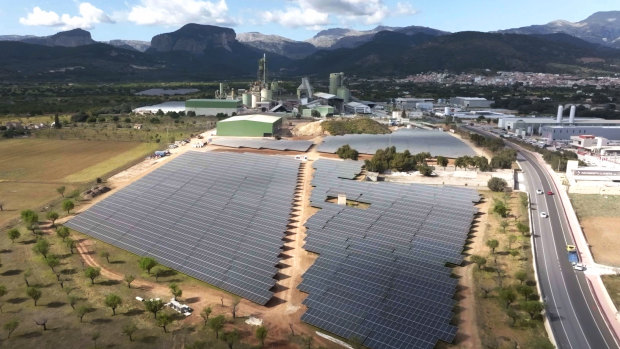Island as energy ecosystem: Mallorca leads the charge on green hydrogen

Save articles for later
Add articles to your saved list and come back to them any time.
Palma: The western Mediterranean isle of Mallorca – famous for its stunning coastline, secluded coves, limestone mountains, architecture and wineries – has long been a playground for the rich, famous and creative types of all leanings.
The city of Palma, on the Spanish island Mallorca, is undergoing a green revolution off the back of investment in green hydrogen.Credit: iStockphoto
Whether it’s Jules Verne, who drew inspiration for his novel Journey to the Centre of the Earth from its underground caves, or Australian businessman Christopher Skase, who tried to make a buck from resorts after fleeing authorities and creditors at home, the island has enchanted.
It’s still the home of Spanish tennis champion Rafael Nadal, a native, and has played host to Hollywood starlets Audrey Hepburn and Elizabeth Taylor.
One of Mallorca’s most famous residents was the English poet and novelist Robert Graves, who moved to the island in 1929. From there he “found everything [he] wanted as a writer: sun, sea, mountains, spring water, shady trees, no politics and a few civilised luxuries such as electric light and a bus service to Palma, the capital”.
Those elements – sun, water, electricity and even the bus service – have now become the centre of a bold bid that puts Mallorca at the forefront of the climate revolution, as a world leader in the race towards net-zero.
A driver fills the tank of an urban bus with green hydrogen at the bus depot of the municipal transport company in Palma de Mallorca.Credit: AP
This summer, minibuses running on green hydrogen have ferried tourists for transfers between the busy airport and their accommodation.
In coming years, energy produced from the island’s hydrogen plant will be used for heating and electricity via fuel cells for commercial and public buildings, including hotels owned by Mallorca-based chain Iberostar.
After that, it aims to supply auxiliary power for ferries and port operations and create a hydrogen refuelling station.
A Spanish province – the Balearic Islands of Mallorca, Ibiza, Menorca and Formentera – operates as an autonomous community.
Like other islands, they are especially vulnerable to climate change. Amid a scorching summer, last month the average temperature of the Balearic Sea was 24.97 degrees – 2.63 degrees higher than the historical average for the day.
But the government has devised a way to use the islands’ insularity to their advantage.
Green hydrogen has been produced at Southern Europe’s first industrial renewable hydrogen plant on the island, at Llosetam, for more than a year, and is powered by one nearby 8.5-megawatt solar plant and another 5.85-megawatt plant that is 30 kilometres away in the town of Petra.
Led by Spanish renewables giant Acciona Energia and gas distributor Enagas, in partnership with cement maker Cemex and the Spanish and Balearic governments, the plant will generate and distribute more than 300 tonnes of hydrogen a year.
A driver fills the tank of an urban bus with green hydrogen at the bus depot of the municipal transport company in Palma de Mallorca.Credit: AFP
Jose Hila, the mayor of Palma, the capital city which is home to three-quarters of the nearly 1 million people who live on the island, says he wants it to be a “national benchmark”. He proudly boasts it is only the second city in Spain, after Barcelona, with a fully renewable plan for its transport system.
“When we took office, we found we had an outdated public transport system, with old vehicles, and we have successfully turned things around,” he said.
“We are clearly committed to innovation, and this has been possible thanks to co-ordination and our ability to reach agreements.”
The aim of all these initiatives is to reduce greenhouse emissions on the island by at least 16,000 tonnes a year. The equivalent to taking 6200 cars off Mallorca roads or planting 30,000 trees.
While critics argue that green hydrogen is now far more expensive than traditional fossil fuels, its many proponents believe its long-term benefits make it a worthwhile investment. The project on Mallorca has cost more than €50 million ($82.6 million) in private and public funding, with an additional €10 million from the European Union.
The project on Mallorca led by Enagas and Acciona Energia aims to green the Balearic island while providing a reference case for other European countries shifting from gas to H2.
The Spanish government estimates that domestic industries, such as chemicals and fertilisers, consume 500,000 tonnes of hydrogen a year. They are generally supplied by “grey” hydrogen, which is extracted from natural gas, and costs as little as €1 to €1.50 a kilo. Green hydrogen from water, by comparison, costs an uncompetitive €5 to €7 a kilo.
But the cost of renewable hydrogen production is expected to decrease significantly as technology improves and economies of scale are realised.
Creating a renewable hydrogen ecosystem – where the energy is not only produced but there is a local market for its use – is expected to serve as a replication model for a group of five other island territories – Tenerife in Spain, Madeira in Portugal, Aran in Ireland, Ameland in the Netherlands and the Greek Islands.
Solar panels stand in front of an old cement factory to produce green hydrogen in Majorca. Credit: Getty
Rafael Mateo, global chief executive of Acciona, said the Mallorca project would allow the maturing of the technology and an economic model based on renewable hydrogen to make a “qualitative leap in decarbonisation”.
He said the biggest challenge was to create demand.
“We have the production, but now we need buyers,” he said. “The advantage of renewables, and the advantage of green hydrogen, is that it’s local, using autonomous resources – so each country can secure its own low-carbon energy at stable prices for 30 years.”
He pointed to the crisis Europe has faced with record-high natural gas prices off the back of the Russian invasion as a reason that countries cannot continue to rely on imported fuel.
“I think if you can have your own energy supply – electricity plus green hydrogen – it doesn’t make sense to import fossil fuels because when you are importing, you are subject to the volatility of the industry and to the volatility of geopolitics.”
Spain’s first industrial facility for renewable hydrogen, on the island of Mallorca is already operating.
Mateo said Acciona could produce green hydrogen in its key markets, such as Spain and Portugal, at “very competitive prices” compared with other parts of Europe, where winds and solar irradiation are not as strong.
Graves, the British-born author, produced some of his greatest work while living on Mallorca, including I Claudius, Count Belisarius and The Golden Fleece. And more than 80 years ago he appeared to spot that the locals were capable of solving the problems they faced.
“The Mallorcan countryside is not at all a place to go in search of inspiration,” he once wrote. “But admirable for people whose minds already teem with ideas that need recording in absolute quiet.”
Get a note directly from our foreign correspondents on what’s making headlines around the world. Sign up for the weekly What in the World newsletter here.
Most Viewed in World
From our partners
Source: Read Full Article
